Seeing Things: February 2011 Archives
Paul Taylor Dance Company / City Center, NYC / February 22 - March 6, 2011
Year after year, Paul Taylor can be counted on to create a pair of new dances--one light (such as the luminous Aureole, from 1962) and one dark (like the 1985 Last Look, which portrays the human race at the horrifying and undeniably convincing end of its rope).
The first of the pair of works new to New York shown in his company's current engagement (February 22 - March 6, at City Center), sported the Edward Gorey-ish title Three Dubious Memories. Presumably this was the light one, though the opening night audience was understandably unsure if it was OK to laugh. For a long-time dance observer, the piece registered a fond if typically ironic survey by Taylor of his inheritance as both dancer and choreographer. Taylor being Taylor, Memories took a wry look at his own contribution to an ongoing tradition in which invention can morph into habit before you know it.
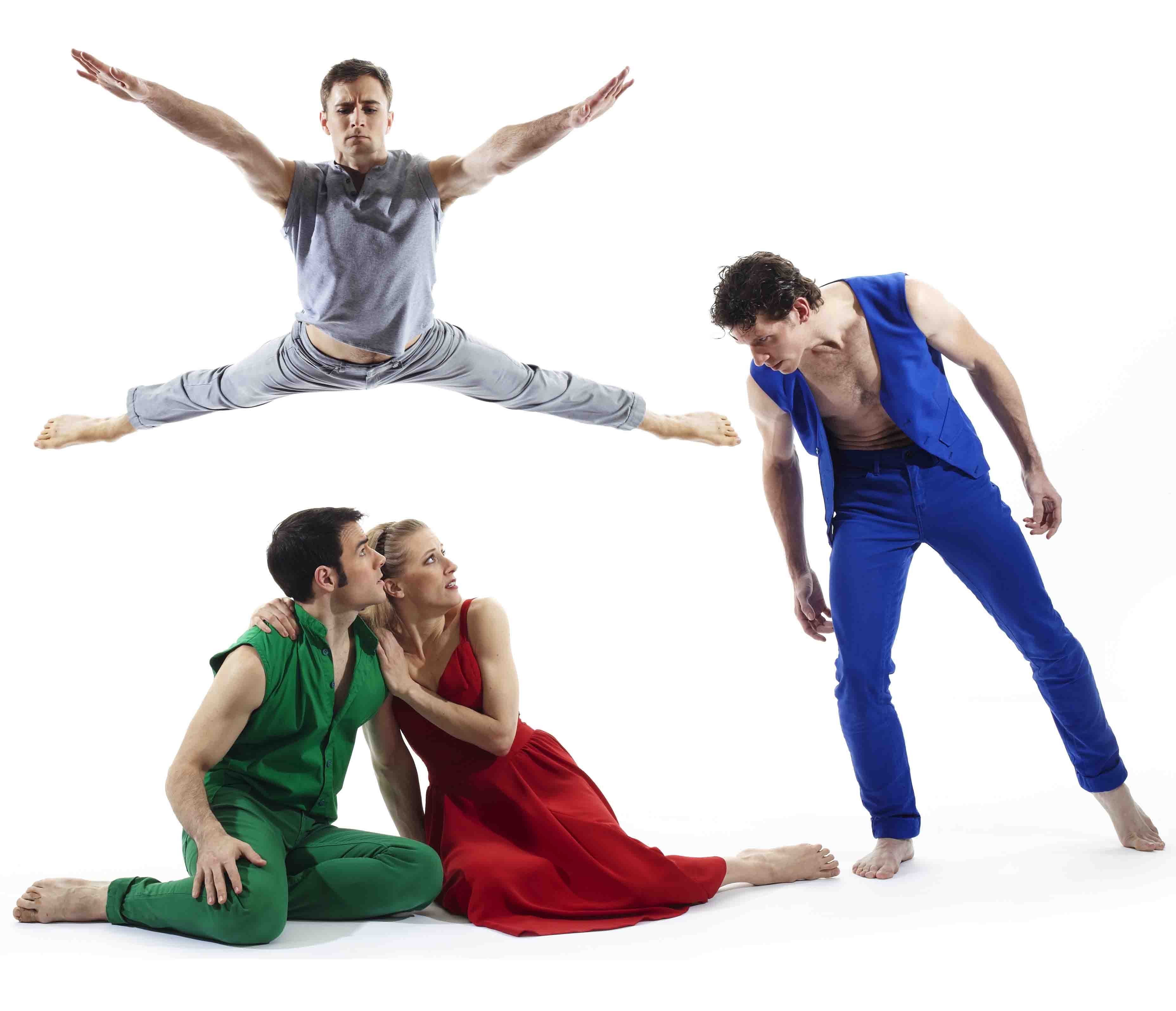
Meet the Stars: James Samson (airborne); (l. to r.) Robert Kleinendorst, Amy Young, and Sean Mahoney in Paul Taylor's Three Dubious Memories
Photo: Tom Caravaglia
The list of characters ("The Woman in Red"), casting ("Messrs. Smith, Graciano, Apuzzo, Novak"), and sections of the dance ("As Remembered by the Man in Blue") are a blatant spoof of Antony Tudor, the master choreographer of psychology and suggestion, with whom Taylor studied in his formative years. The actual proceedings (vivid drama with mythical implications) and the gut-sprung movement vocabulary concentrate on what he absorbed as a leading dancer with Martha Graham, diva and queen of the 20th century's "Major Moderns." Graham herself liked to say, "I only steal from the best," but even as Taylor quotes, borrows, and steals from the lady, he never quite manages--here and in some previous works--to suspend his disbelief in her highly-colored aesthetic.
Set to Peter Elyakim Taussig's Five Enigmas, Taylor's trio of questionable recollections concerns two guys (one in blue and t'other in green) and that gal in red (Graham's favorite color for flamboyance). The protagonists' shifting interrelationships are played out like courtroom testimony as to what really went on among the three. Their conflicting Rashomon-like reports run the gamut from tender boy/girl love interrupted by various violent attacks to a he/he coupling that begins with buddy-like horsing around--to which Ms. Red naturally objects. But these color-coded personages are mere stick figures acting out banal, if melodramatic, scenarios--not unique temperaments seriously invested in their desires.
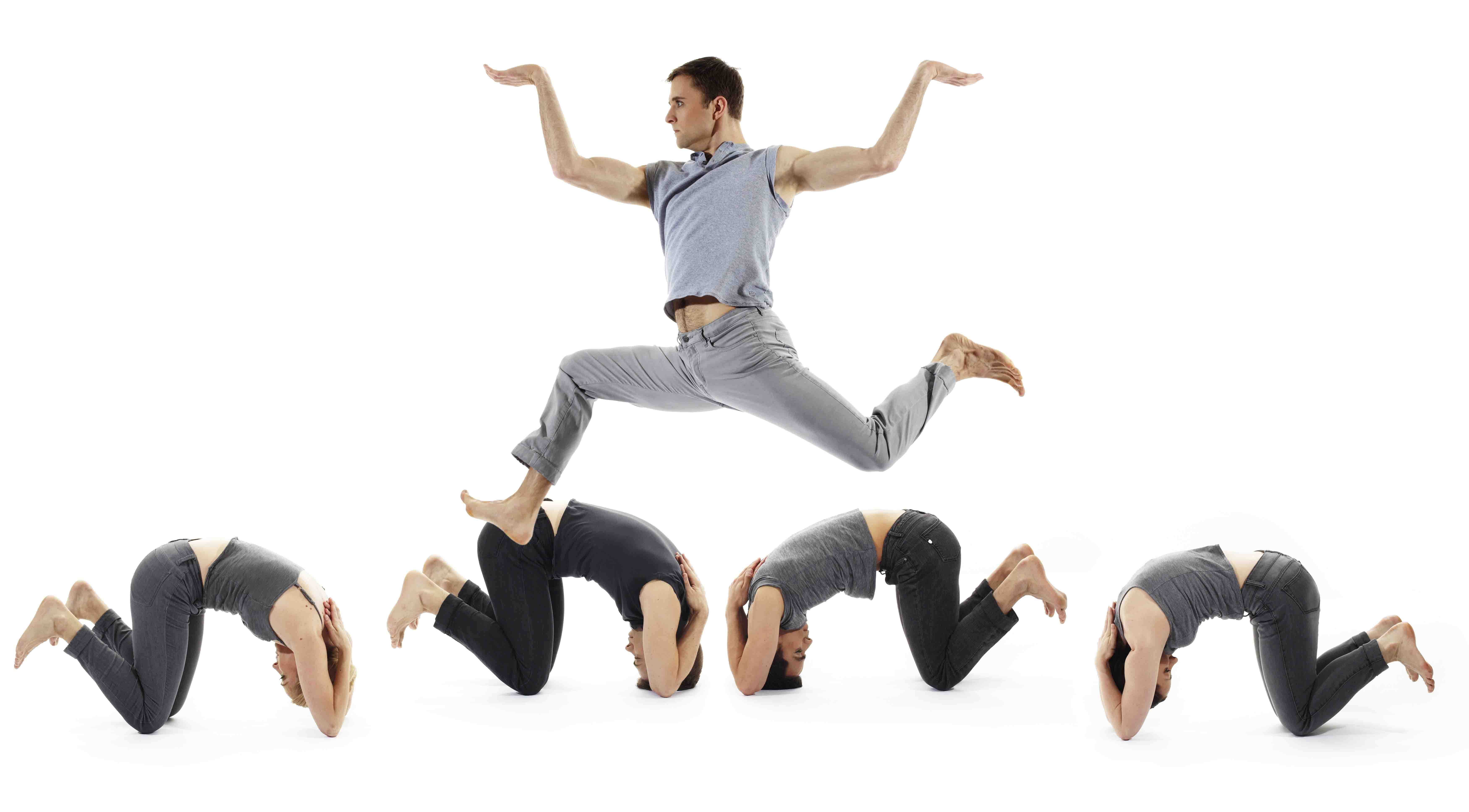
Haven't We Done This Somewhere Before? James Samson as Choirmaster with some of his followers in Three Dubious Memories
Photo: Tom Caravaglia
The sole rich character in Three Dubious Memories is a collective one--The Choirmaster and his seven Choristers. They constitute the judge and jury who must hear the inconsistent testimony and decide where truth lies. I imagine that, in conversation, Taylor might well say "They're all right," and leave the question unsettled. Indeed, it's there that he leaves the piece, perhaps having persuaded his most receptive viewers to realize that experience never has a definite truth but is strangely subjective.
The "choral" group refers back to Graham's masterly choruses, especially to the small bevy of women and their Leader in Night Journey, which relates the tragedy of Oedipus and Jocasta, in her Greek cycle of dances. Taylor's chorus, dressed in the simplest of practice clothes in shades of industrial gray, has what you might call all the best lines.

Hieroglyphic Frieze: Eran Bugge, Michael Novak, Francisco Graciano, and Jamie Rae Walker as Choristers in Three Dubious Memories
Photo: Tom Caravaglia
The Choirmaster moves in counterpoint to his seven subordinates, who typically work in unison, emphasizing the idea of many individuals' becoming a singular force with singular power. Often they operate in the two-dimensional mode typical of ancient Egyptian art--head, legs, and feet presented in profile, chest seen full-frontal--a device that Taylor borrowed brilliantly for his 1980 Sacre du Printemps (The Rehearsal).
Sitting or squatting, they become self-contained statues of Asian gods. Supine, they flutter their hands in the air to create an army of butterflies. Upright, they extend an arm straight ahead of them, sharply angling the wrist so the hand flips upwards to form a shield that would halt anyone or anything in its tracks. Taylor lavishes a huge vocabulary on these figures; they seem to be the vehicle of his imagination.
The opening night program, which included the expendable Oh, You Kid!, began with one of the best performances of Taylor's celebrated Esplanade I've ever witnessed. It looked as if it had been taken apart, scrupulously reconsidered, then polished to a high degree of freshness and--believe it or not--spontaneity. This dance, deliberately made without formal dance steps but instead with "pedestrian" elements like hell-bent running, ebullient jumps, slides, falls, and meditative walking (often cradling another body) is exhilarating in its sheer physicality.
The middle section, built from the subtlest of ordinary gestures--extending a hand or turning away, crawling in an ever-tightening huddle, like a herd of sheep sheltering from a storm--is devastating in the feelings it projects or, rather, suggests. Without identifying characters, providing a narrative, or succumbing to acting in its usual sense, this section conjures up thwarted family relationships and makes the weight of them almost unbearable.
The viewer is rescued from despair by the final section of the dance, which has the full cast skidding and plummeting to the ground in a dozen different ways and rising to fall again (and again) as it joyously challenges imaginary high winds. Esplanade could be an advertisement for "Life--despite everything." The audience I was part of responded with near-hysterical enthusiasm.
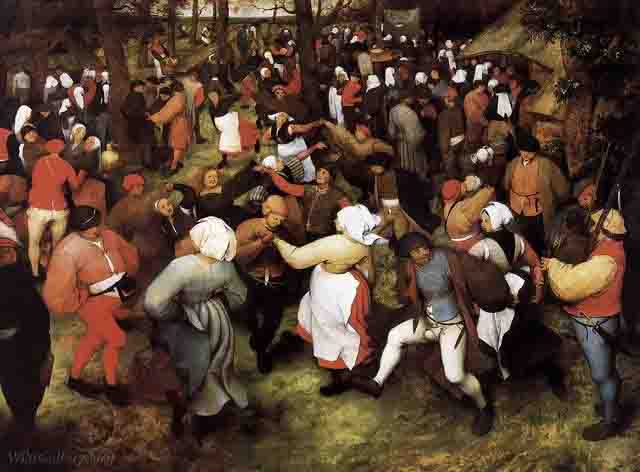
Pieter Brueghel the Elder, The Wedding Dance in the Open Air (1566)
Detroit Institute of Art
Photo source: WikiGallery
Part of Taylor's inspiration for Phantasmagoria, the season's second newish piece, came from a painting--Pieter Brueghel the Elder's 1566 Wedding Dance in the Open Air, about which William Carlos Williams wrote:
Disciplined by the artist
to go round
& round
in holiday gear
a riotously gay rabble of
peasants and their
ample-bottomed doxies
fills
the market square . . .
Painter and poet describe a dance I think Taylor would enjoy watching--even, in his thoughts, being part of--but as a choreographer he can't sustain a portrayal of it or come up with a contemporary equivalent. (Mark Morris is our man for that.) Only the opening tableau of Taylor's dance fits Brueghel's lusty image, and that largely thanks to Santo Loquasto's costumes (faithful enough to replicate the men's aroused privates).
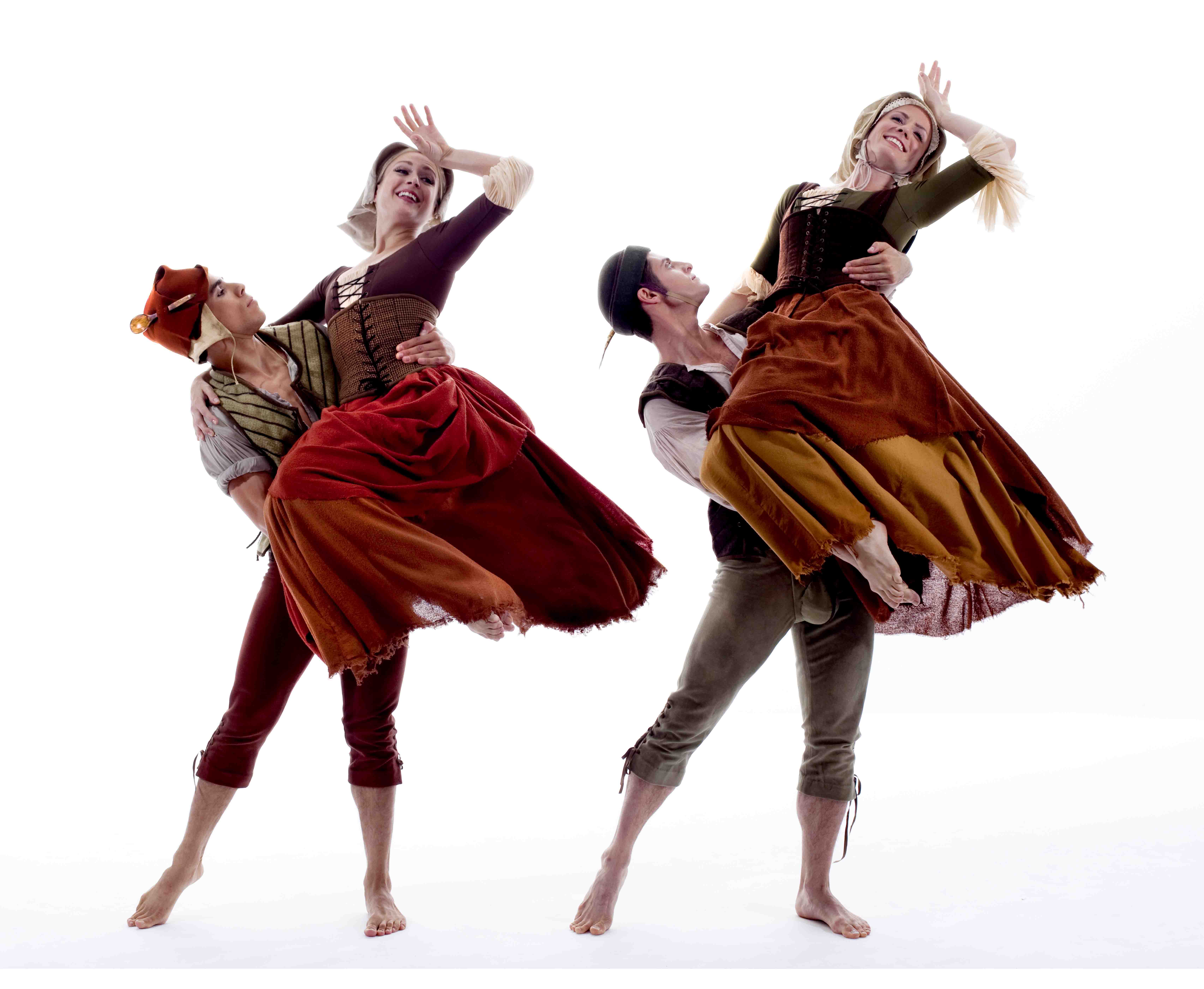
Flemish Frolics: (l.) Francisco Graciano and Jamie Rae Walker; (r.) Michael Apuzzo and Eran Bugge in Taylor's Phantasmagoria
Photo: Tom Caravaglia
Taylor is quick to report the other side of human existence, showing the life-affirming Flemish crew plagued by difficulty, grief, and bitter rage. But then, for no apparent reason--and though the dance is set to a Taylor-made collage of Renaissance music--he moves on to a fast-forward slide show of unrelated scenes. First he offers us an "East Indian Adam and Eve" in glittering costumes making lascivious use of a sex toy in the shape of a long plush snake. A "Byzantine nun" with a high, pointed headdress shoos them off, only to dally with the reptile herself. Michelle Fleet, who is having her best season yet, appears to do a round of Irish step dancing, her arms hanging quietly by the sides of her motionless torso while her footgear, reinforced by taps, chatters on beneath her.
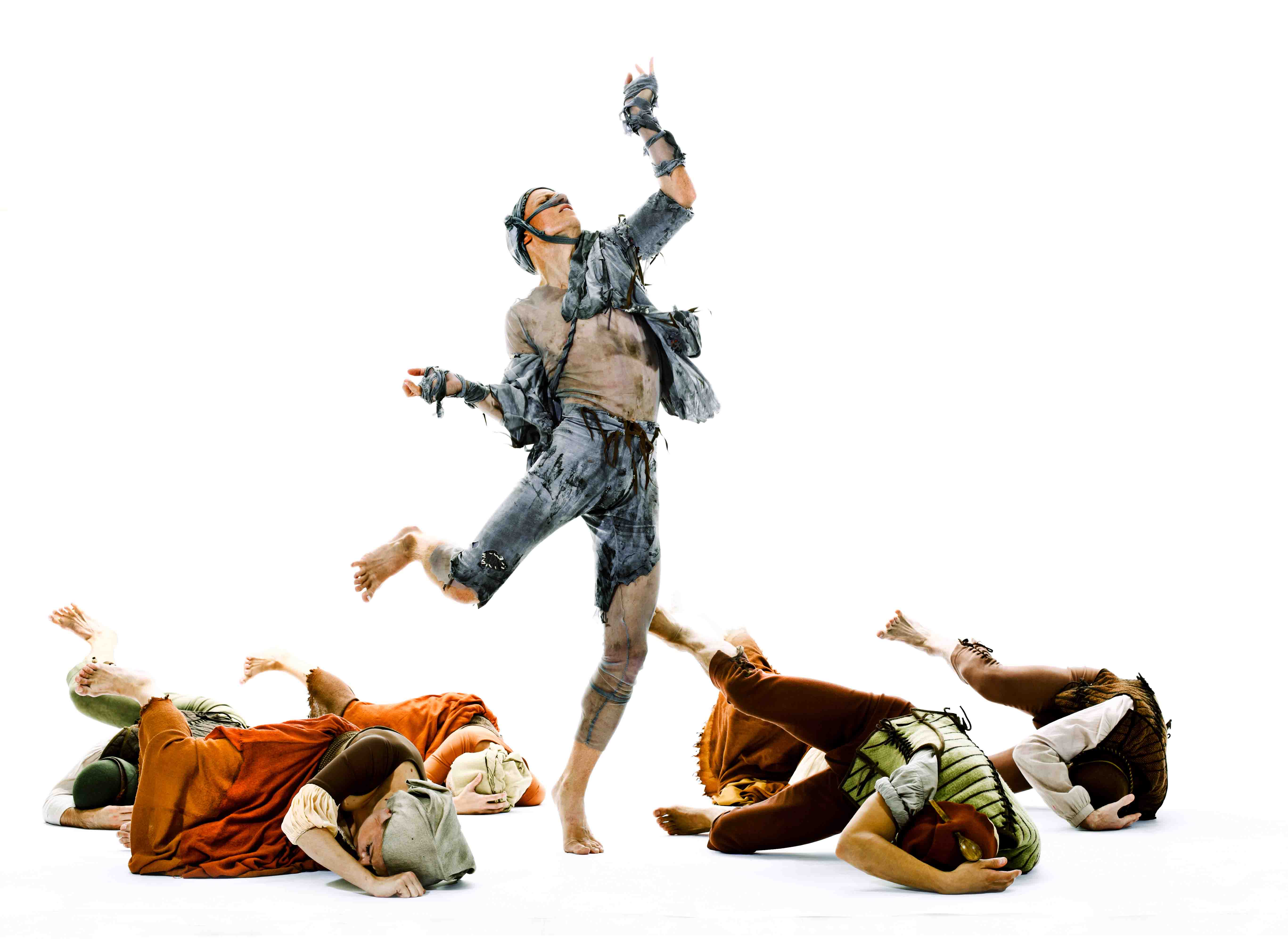
The Plague: Michael Trusnovic and members of the Paul Taylor Dance Company in Phantasmagoria
Photo: Tom Caravaglia
A quartet of unruly peasant fellows is replaced by a floaty, saccharine trio of Isadorables, who are in turn harassed by a "Bowery bum." The wino, played by Robert Kleinendorst, paper-bagged bottle in hand, is appropriately besmirched and disheveled, with a lurching gait and a personality that's somehow endearing. The final figure added to this improbable--and unconvincing--mix is a figure of death (Michael Trusnovec, usually assigned Apollonic roles), who transmits his disease, St. Vitus's dance, to all and sundry. The full cast starts writhing itself out of this world, then resurrects for a cheerier finale.
So, as it turns out, Phantasmagoria is light--rather than the dark piece I'd assumed we were owed--and not merely light, in the sense of light-spirited but, alas, light-weight in intent and invention. Taylor has exercised his sense of humor here in its silly, immature guise, as if trying to see, as he does periodically, if he can get away with nonsense. That's fine with me, on the boys-will-be-boys principle, as long as I don't have to see the results a second time.
The dances that accompanied Phantasmagoria on its first night in town, however, rank among Taylor's finest. Polaris and Cloven Kingdom, both created in 1976, surely a vintage year for the choreographer, were given vivid--indeed, riveting--performances.
All the dances I've mentioned were lighted by Jennifer Tipton, the most sensitive artist in her intangible domain.
© 2011 Tobi Tobias
My first memory of steps dates back to my childhood--extreme infancy, to be exact. Science tells us we don't remember the earliest part of life, and no one I know has ever claimed to. So what makes me think that I can remember--actually feel again--the slow bump, bump, bump as my beloved Aunt Ann, my mother's elder sister, cradling me carefully in her arms, descended to the street via the front steps of the hospital in which I'd been born just a few days before?
Friends tell me I must have made up that memory a few years later, inspired by my father's amateur photograph of the event, which had taken a place of honor in our family album. But I don't remember the descent pictorially, just viscerally: Bump, bump, bump, as my tiny, relaxed body, swathed in a warm mist, thanks to a cozy blanket of fleece, moved with slow, steady, rhythm, down one level to the next. Of course, as Aunt Ann carried me, I didn't know she was my aunt, or even what an aunt was, but a quarter century later I named my daughter after her. I leave it to you to decide if that first, primal memory could be true. As for me, I think what I think and I know what I know.
THE BABY AND THE STAIRCASE
Once a child can crawl, he soon moves on to the challenge of staircases. Ascending them isn't too difficult, essentially in crawl position, admittedly made somewhat more challenging by the upward tilt--don't even think of this on steep flights--and next in upright position with the support of a banister on one side and a watchful adult with quick reflexes on the other. In both cases, if possible, the child should be encouraged to look straight in front of him, never behind. It's a long way down.
Descending a flight of stairs often enters a baby's repertoire first, because the easiest technique is to descend backwards in what is, again, essentially crawl position, simply tilted to match the staircase's slant. An observer standing at the bottom of this flight of stairs sees the cute little bottom, well padded with diaper under the eager toiler's workaday outfit; this is the well-deserved reward for the caretaker who had the patience and watchfulness to teach the stair-crawler the trick in the first place.
According to this era's baby books, the appropriate congratulation to the child for success in this maneuver--and most any other physical achievement--is "Good job!" so as to reinforce the idea that achievement at a particular task (or failure, to be greeted with a cheery "It's coming along") is not misunderstood by the child to be a judgment about his or her identity as a whole. And here I was, saving "good job" for winning a Rhodes scholarship.
STEP-STOOLS
Before you know it, the child is a toddler, and, having mastered walking to a reasonable, if erratic, degree, often acquires a two-step stool that puts him or her at the right height to use the bathroom sink. My own pair of offspring used one-step affairs, coated in gleaming enamel--one yellow, one red--with wheels imbedded in one side that let them go scooting across the floor, propelled by their legs and feet. Turned over, the objects became flat-topped stools with a hole for carrying them about from wild hallway races to a more decorous washing-hands-before-dinner position. These stools were pieces of invention and plain sleek beauty--at a hefty price--so popular with "advanced" parents of the sixties. When my kids outgrew these handsome devices, they were passed on to younger kids in our circle, so, a generation later, I had to start from scratch for my two granddaughters, preschoolers, who lived nearby. Fortunately, the need arose when I was in my vintage phase, and I found at a church sale a battered wooden affair from, I'd guess, the 1930s or '40s that sported nursery rhymes with illustrative pictures, all faded by time and use. My daughter (the little girls' mother) and I loved it a lot. To hell with the Bauhaus. This one had the charm of yesteryear.
JUMPING FROM HEIGHTS
Is there some mathematical law dictating that a child will always jump from a height two steps higher on a stoop than his or her grandmother considers even marginally safe? What impels children to start doing this? The perilous jumping lasts, in my experience, for two years and then vanishes forever, with many a skinned knee to show for it. With barely concealed pride.
OUR STAIRCASES
Lacking risers, the staircases in our own house are lethal. A riser, for folks who have happily managed to avoid the lingo of architecture, is the vertical piece between two horizontal steps (treads, as the trade calls them). Architects love to omit risers, so as to give the staircase space more light and make it seem lighter in weight as well. Lovely visually, but at our place a small enough child can slip straight from the third floor to the basement. (To increase the danger--and, granted, the floating effect--there is sheer empty space between the banisters and the treads.)
We had to carry our grandchildren up and down these staircases until they were three or four and far too heavy for a grandparent to make the trip with the preschooler in his arms. When we reached that stage, Staircase Rules were drummed into the kids' heads: Don't use the stairs without a grown-up. Don't use the stairs when you're wearing only socks; you might slip. Don't carry anything when you're going up or down. Hold on to the banister. No playing on the stairs and no dashing up or down them.
"Why would anybody build stairs kids can't use?" the youngest grand asked, in a tone more hostile than plaintive. We finally stopped reiterating the rules when her elder sister got two numbers to her age, but their visiting friends still have to be reminded occasionally. It's a miracle--not that no one has fallen, but that the children are still speaking to us.
CLIMBING INSIDE THE STATUE OF LIBERTY
When I was a child, our family and a neighbor's took the Battery Park ferry to the Statue of Liberty and climbed the 546 steps (from ground level to the top of the crown) inside the Brobdingnagian sculpture. It was a glorious adventure, climaxing in the view from the top and ending, when we finally got down, with a lavish picnic. Sure enough, the following day brought formidably aching muscles, hot baths, intermittent bed rest, and melodramatic groans. One of the adults in our group had pointed out that we could use an elevator that would take us painlessly as far as the top of the pedestal on which Lady Liberty stands, armed with book clasped close to her bosom and torch held high, thus saving 192 steps. We children had retorted as one, "But it wouldn't be the same." This is undeniably true.
STOOP BALL
The authentic game is related to baseball, I read recently. Girls in Brooklyn's East Flatbush, at least when I was one of them, played a simpler version. Basically you took turns throwing a pink rubber ball (classically a Spaldeen, as we called the Spalding company's specialty), from a stance on the sidewalk toward the stairs of a house stoop. Brownstones, with their high flights, were favorite sites.
An ordinary throw that hit the stoop and was allowed to bounce just once before you caught it got you 10 points. Easy stuff. The value of hitting the edge of a step with your ball, catching it without allowing it to bounce on the ground as it slammed back to you, was 100. Both parts of the 100-point feat were tricky. Not often succeeding, they carried great cachet, partly, no doubt, because of the danger factor. Those off-the-edge-of-the-step missiles packed a wallop on the rebound, and you might get hit in the face. Sometimes you failed to catch the ball after it had bounced once, and it dribbled gaily past you, along the sidewalk and out into the street. Then the only honor was not to run into the street after it and be mowed down by a passing car. There were, needless to say, no points awarded for caution.
It was lovely to play after dinner, in summer, when the sun set late. In the slowly fading light, the throws became harder to aim well and any competition the game had aroused in full daylight imperceptibly gave way to the mood of a languorous dream. All too soon though, our mothers were leaning out from their kitchen windows, calling us in to bath and bedtime, no doubt relieved to see that another day had passed in which no child they knew had crossed paths with a moving car.
When we had a whole afternoon before us and no one had to go off to a piano lesson or the orthodontist, whoever achieved the remarkable tally of 1000 points won the game. Mostly, though, these games never reached that definitive, triumphant conclusion. Getting there became too tedious. When we lost interest, we'd just drift off into another of the pastimes that, today, seem to exist only in memory.
DEATH
How old was I then? Eight? Nine? Ten at the most. I was walking down the staircase in our two-story house. The steps were carpeted, the thick pile absorbing nearly all footfalls. I stopped, hearing voices from a little sitting room below: my mother's and the varying sopranos and mezzos of two--or was it three?--of her friends from the neighborhood. I couldn't make out what they were saying, but their voices were warm and cheerful, a springtime medley of chirping birds. I heard them but they hadn't heard me. They couldn't see me either; a wall divided the staircase from the room they were in. I thought, This is what it's like when you're dead. The world goes on doing what it always does. Except that you're not there. I felt hollow. I was gone, and no one seemed to notice.
READING ON PARK STEPS
As a teen on summer vacation, I often spent an entire afternoon reading yesteryear's French classics in the old MoMA Sculpture Garden. It was one of the cheapest ways I knew to feel truly sophisticated. I had been given a year's membership in the museum, so the experience was entirely free, apart from the price of an espresso from the refreshment cart. The MoMA garden had chairs, but I preferred sitting on one of the wide stone platforms that also varied the heights of the terrain, suggested different areas, and were low enough to serve as steps. Such a rare and elegant perch seemed more in keeping with Racine's cadences, which, reading his nobly impassioned scenes or reciting them sotto voce, was like swirling a sip of superb brandy inside your mouth.
Two summers later found me reading all afternoon in Washington Square Park during the season's break at Barnard (my alma mater, too high-toned for summer courses) when I attended the more plebian NYU to earn credits that would let me begin my master's degree while still an undergraduate. For some reason, I thought this acceleration would be practical, but perhaps there was a romantic aspect lurking behind my behavior as well. Once you slipped away from Barnard's all-female student body, there was no telling whom you might meet.
So after classes all morning (we were squeezing semester-long courses into six weeks), I would retire to the huge circle with a fountain at its center in the park that's a Village landmark, which had a few graduated rows of steps in concentric circles on its inner side. As rumpled old men played chess nearby, young mothers aired their babies (while their husbands, no doubt, labored over their doctoral dissertations), hippies played their guitars, Jules Feiffer-style dancers scurried to their rehearsals, and Judson Church tirelessly championed liberal causes, I sat and did the day's assigned reading.
One afternoon I noticed a handsome older man who watched me from a polite distance for over an hour. Every ten minutes or so I raised my eyes furtively from Chekhov's heart-rending short stories--or was it Molière's Les Femmes Savantes?--then methodically continued my reading. Finally--it was nearing sundown--I finished my task and closed my book. The man took this as his signal to approach close enough for conversation.
"Hello," he said. "You seem to be finished with your work. May I walk you home?"
Maybe his good looks, to say nothing of his suave manner were merely lures. He was also at least fifteen years older than I. Even to my relative innocence, his proposal felt like Not a Very Good Idea. And I was sure he had no idea that the home he offered to walk me to was deep in Brooklyn and inhabited by my very protective parents.
"No, thank you," I said in what I hoped was a tone of sophisticated hauteur and went briskly on my own way. I wonder why I still remember this.
DANISH STEPS
My present to my daughter for her high-school graduation was two weeks in a single European city. She chose Copenhagen; she'd heard good things about it. I'd made many friends there on working-and-playing trips before that and, of course, when Anne and I arrived, all those friends asked us to dinner. I had never quite realized, before that trip with my daughter, how many of my friends lived in fifth-floor walk-ups. We always arrived at their door panting.
The most intimidating staircase in Copenhagen, though--admit it, the scariest--is the one that spirals around the outside of the steeple tower of Vor Frelsers Kirke (Our Savior's Church). Of course we climbed it (we were extremely thorough tourists), I trembling with terror though I tried not to reveal it to my teenager; Anne herself increasingly blithe-spirited. Did I mention that the winds were high that day? Finally, Anne stood on the very top step, her long chestnut hair blown into rivulets. I stood, now frozen by fear, two steps below her and took her picture. I behaved as if I needed the lower perch to take the photograph but, truth to tell, I couldn't mount a step further.
THE SUBWAY UPSTAIRS
At 10, my youngest grand is the girl her early childhood promised: tall, slender, willowy, strikingly pale, and now a crackerjack athlete, with extraordinary eye-hand coordination and surprising physical stamina.
When she was not quite four, it was one of my grandmotherly duties and pleasures to collect her from her preschool on West 121st Street once a week at midday, ferry her by subway (the Broadway bus took forever) back to my house on West 96th, and entertain her until returning her to her parents for dinner. After making this trip myriad times, it occurred to me that instead of boarding the subway at 116th, as directed in the "official" parental instructions, we could shorten our walk by boarding at 125th Street station. So one (exceedingly hot and humid) day we tried. Turns out 125th is an elevated station. Go know.
I can't tell you how many steps we had to climb to reach the platform, but toil away the child did (she being too heavy to carry even part of the way up), without complaint. Not at all to my surprise, she even took the discouraging circumstances in good humor, pretending we were scaling Mt. Everest, and so on. I should have known; she has always been a cheerful traveler. The only time I've heard her admit to exhaustion was when we sat on a park bench, trying to get our strength back in the middle of a far too long walk we attempted one day. "I wish I had a stroller," she mused aloud, "or a wheelchair."
VIEWING THE BROOKLYN MUSEUM FOUNTAIN FROM ITS AMPHITHEATER STEPS
In 2004, the Brooklyn Museum added to its wonders a beautiful, compelling fountain, created by WET Design, and a handsome structure of concrete amphitheater-style steps, overlaid with wood, for comfort, on which you can sit to contemplate it.
Shaker-plain in construction, spectacular in action, the fountain consists of two parallel rows laid out in a long, subtly curved horizontal path. From nearly invisible outlets at ground level, jets of water spring skyward, then retreat, the plumes of water falling straight back upon themselves, to end in a grand splash, only to rise again.The magic lies in the orchestration of the event. The amount of water and the force with which it's driven into the air varies from Lilliputian and gentle, making you think of a bubbling brook, to towering thrusts toward the heavens, suggesting energy of the highest power, and, of course, several heights and pressures in between. The arrangement of which streams of water go high, which go low, which in between--and when--results in stunning pictures etched on space: of curves, waves, unpredictably sloping lines, and pageants of synchronized marchers deploying their most inventive stunts. Remember, all these ephemeral images are composed of single jets projected unerringly upward. (Andy Newman, writing in the New York Times, called the effect "liquid fireworks.") Returning to their source, single drops of water from the vertical jets register as colorless transparent jewels of all sizes, each incredibly clear-edged, suspended for a microsecond between earth and sky.
Occasionally the spouting water disappears entirely, as if resting before its next exploit, while the viewers on the amphitheater steps, perhaps in complement to the sudden nothingness, grow particularly quiet. Could they be wondering, as I was at first, if they'd imagined the whole display?
Upon discovering the fountain, serendipitously, my elder granddaughter and I began to combine a fountain viewing with our usual excursions to the museum itself, or to the Botanic Garden, just next door. But little by little I realized the fountain alone was a major destination, so the youngster and I have agreed on 45 minutes watching the fountain before a visit to, say, the museum's outstanding Egyptian and African collections, its American art, and its period rooms or to the famous cherry trees and atmospheric walks through contrasting aspects of nature in the Botanic Garden, finishing with a second 45 minutes of fountain contemplation. I suspect the time at the fountain may need to be increased further; she leaves it so reluctantly, as if parting with a friend about to move to some faraway place, whom she may never see again.
Invariably she watches the fountain with a mesmerized look on her face.
"Are you hypnotized by the fountain?" I asked, teasingly, one day.
"No," she replied, highly serious. "I am trying to figure out the pattern." I think she has her work cut out for her. The complex order of the water's antics seems either to have a very long loop or works in some way at random. I have just discovered, though, that the fountain is occasionally on at night. I can't wait to witness that scene in her company.
MISS TULLY'S STAIRCASE
To my mind, the best element of the renovated Alice Tully Hall at Lincoln Center is the cluster of high-rising steps just outside it, facing the building, thus shielded from the street, and angled in sections to complement the overall design--Diller Scofidio + Renfro's.
Gloomy is the only word for the original architecture, though the auditorium had decent acoustics. Now the building looks like a glass spaceship with pointed sky-piercing protuberances, blinding when the sun strikes it and, with every wine glass in the interior café visible from the street, utterly devoid of privacy. It is the spitting image of today's culture. For me, the makeover's redeeming feature, which may even have been an afterthought, is those outdoor steps. They humanize the portentous renovation. Children clamber over them. Unassuming-looking folks consume the sandwiches they've brought with them. Lovers of all ages sit close, side by side, murmuring to each other. Friends exchange information, opinion, and mere gossip with animation. Loners read, knit, or stare meditatively ahead, as if they were considering the trajectory of their lives. That clever arrangement of stairs turns it into a communal front stoop.
STAIRWAY TO HEAVEN
At the close of Apollo, George Balanchine's incomparable early ballet, the trio of muses the young god has played with and gravely judged as part of his growing from birth to manhood--Terpsichore, Polyhymnia, and Calliope--follow him in a line as he walks solemnly to a stark staircase, which we see in profile, and ascends it. When he reaches the top step, they all stop, like a procession of figures in an ecstatic frieze, and stretch one gently curved arm toward the heavens. You're not likely to see this anymore because, late in his career, the choreographer cut both the opening of the work (Apollo's birth) and that last passage (both dependent on the staircase), ostensibly to remove any narrative from the piece. But if you saw it back in the day of--oh, so many remarkable things--you can imagine it, and I frequently do.
© 2011 Tobi Tobias
New York City Ballet: Susan Stroman's For the Love of Duke / David H. Koch Theater, Lincoln Center, NYC / January 28, 30M, February 3, 4, 5M, 6M, 2011
For reasons that still remain unfathomable to me, New York City Ballet commissioned yet another piece from Susan Stroman, the choreographer who has won every award in the book for her Broadway productions. (If they invented a Pulitzer prize for choreography, I bet she'd be the first to snare it.)
The new item, Frankie and Johnny . . . and Rose, given its premiere on January 28, is now joined to Stroman's Blossom Got Kissed, made for City Ballet in 1999. The two pieces, under the umbrella title For the Love of Duke, are connected simply by being danced to Duke Ellington songs performed on stage by the David Berger Jazz Orchestra. They also have in common a superficial take on human experience and no take whatsoever on how to use, let alone expand, the classical dance vocabulary.
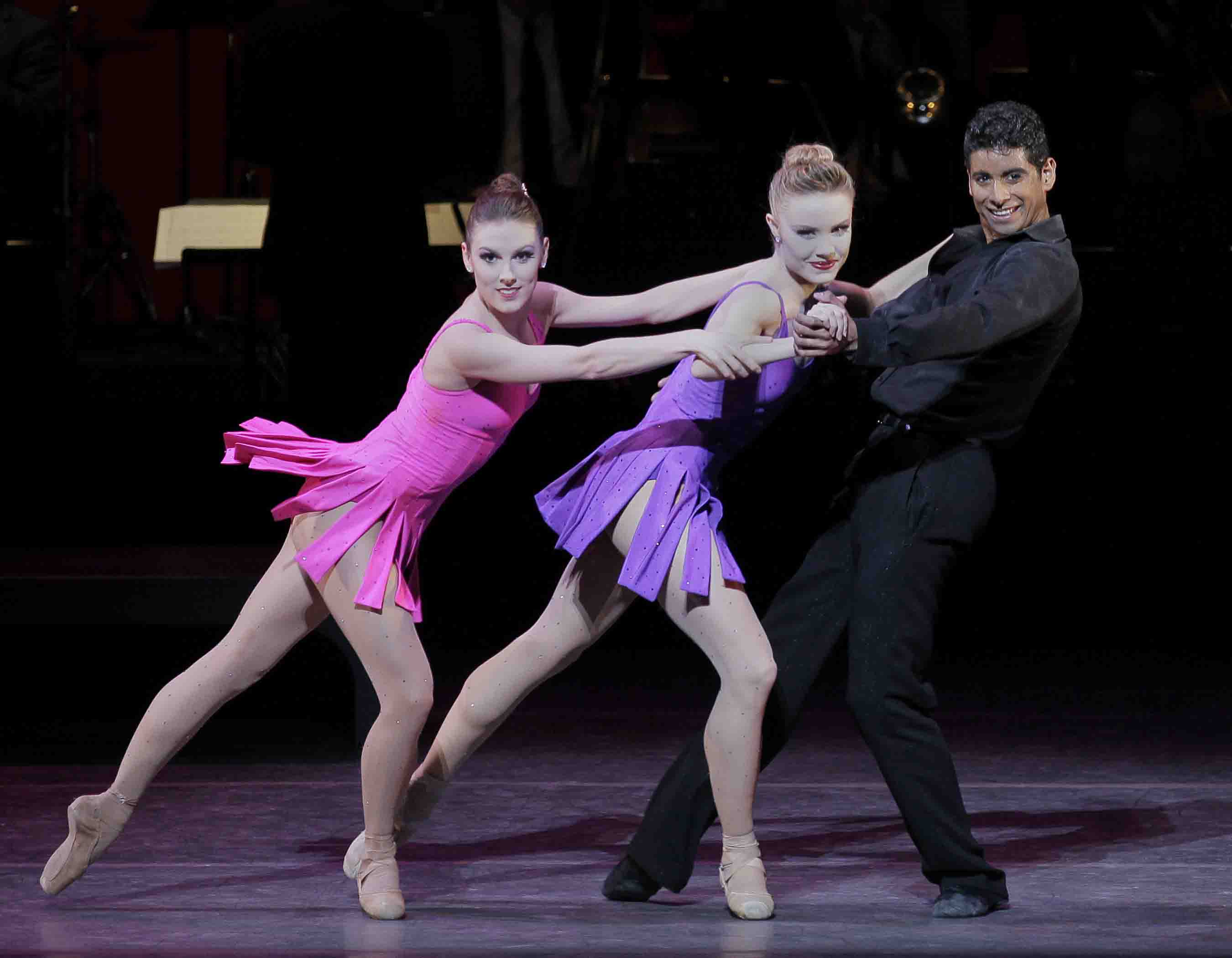
Three's a Crowd: New York City Ballet's Tiler Peck, Sara Mearns, and Amar Ramasar in the Frankie and Johnny . . . and Rose section of Susan Stroman's For the Love of Duke
Photo: Paul Kolnik
Anyway . . . Tiler Peck, who has developed into the most photogenic , vivacious, and technically proficient of City Ballet's women, is Rose, in love with Johnny (Amar Ramasar), who is not entirely convinced he's in love with her. Once Frankie (Sara Mearns, an earth-goddess type) appears, he's smitten. The choreography doesn't clue us in to why our Johnny prefers one women to the other; it makes them seem exactly alike--a neat trick, I must say, with high-profile stars like these.
The characters' routine romantic vagaries take place on and around a longish bench in front of the orchestra, with the protagonists shoving underneath it the person they currently need to have out of the picture. Mearns gets the guy--for a while--but Peck, who gets stuffed under the bench in the process, reappears to assert her claim. Her comeback is short-lived; Ramasar and Peck push her under the bench. Eventually a ménage à trois situation evolves, with the women in catfight mode, while Ramasar is delighted happy to have both chicks at his disposal. The ladies, now furious, team up to kick their fickle beau out of sight and stride off haughtily. (Call this slapstick if you will, but it's not very funny.) Finally Ramasar surfaces--to be joined by a woman from the Blossom part of the program who pops up to connect the two episodes.
Peck, Mearns, and Ramasar do their best according to the instructions they've been given, which apparently disregard the fact that dancers need to do most of their acting with their bodies, not their faces. Stroman's idea of Johnny has Ramasar looking absolutely bug-eyed, a fool no woman of parts would want to date. Peck and Mearns go pretty much blank, performing impeccably but with an "I'm just doing my job" subtext. Since the job of these women, whom we think of as ballerinas, includes repeated swift excursions into a doubtlessly claustrophobic hidey-hole and wearing sheer flesh-colored tights strewn with tiny spangles, they deserve our admiration all the more.
Blossom Got Kissed aims to describe the troubles and triumph of a ballet-schooled ingénue in an over-fluffy, powder blue tutu. The problem? She can't fit in with seven showgirls who've got rhythm (this means they can move to jazz and attract snazzy look-alike boyfriends). The solution? Same as the one the ballet master proposes in Black Swan. (Will that movie never go away?)
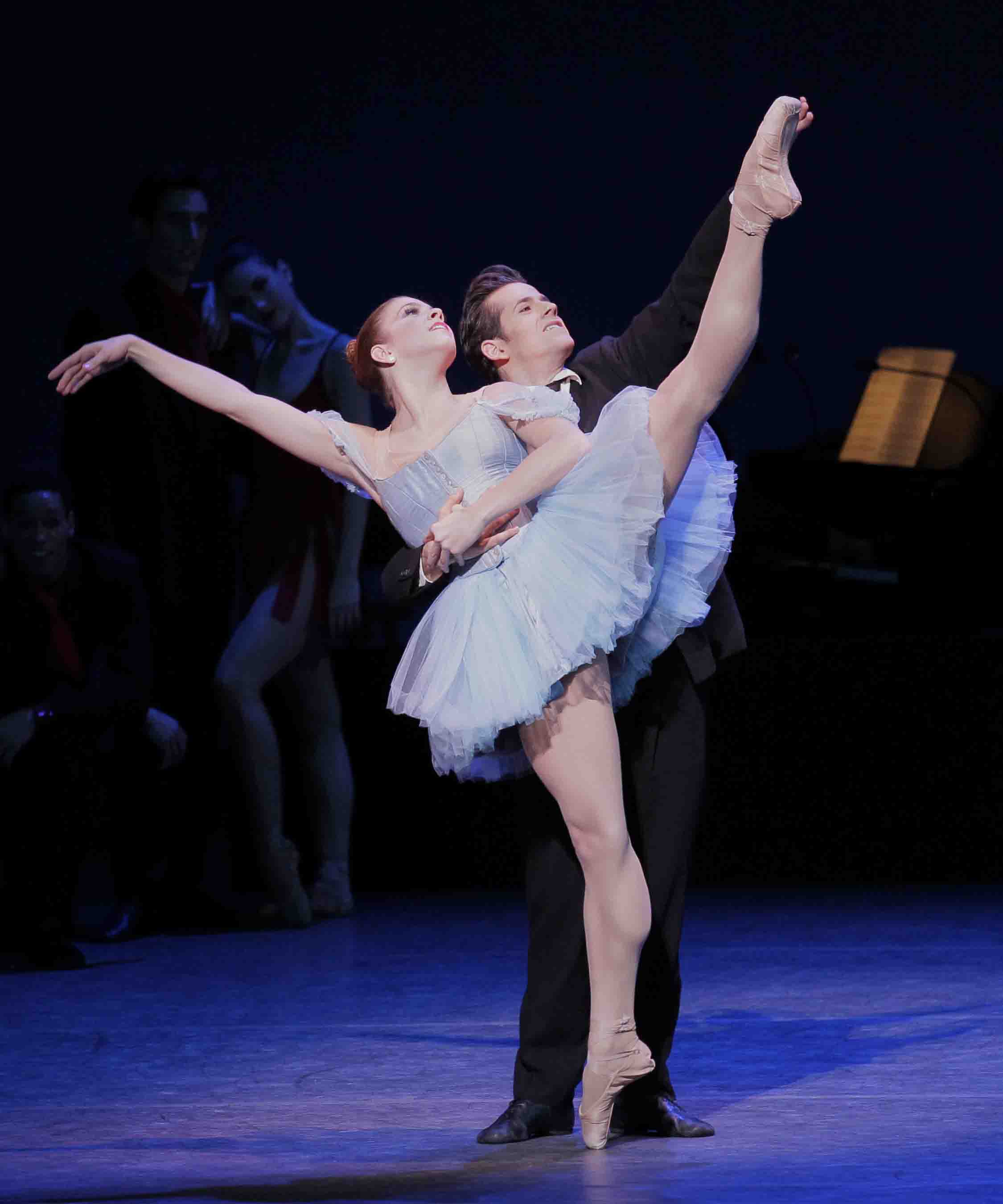
Prelude to a Kiss: Savannah Lowery and Robert Fairchild in the Blossom Got Kissed section of Stroman's For the Love of Duke
Photo: Paul Kolnik
Disguised as a member of the jazz orchestra, Robert Fairchild emerges to partner Blossom, who, slowly but surely, melts in his arms. Having banished the misfit's awkwardness, this latter-day prince nobly concludes their duet by chastely kissing her hand. "Awakened," she sheds her tutu for one of William Ivey Long's sharply cut screaming vermilion practice tunics that the other girls sport. On the first curtain call, Fairchild leans Blossom at a precarious angle to the floor, and gives her the real thing: a lusty kiss on the lips.
The awfulness of all this was compounded by the fact that, as Blossom, Savannah Lowery gave one of the most grotesque performances I've seen in the years I've been watching City Ballet. Her movement style seemed genuinely clumsy, not "pretend"--even after Fairchild's ministrations. Add to this brash self-presentation, a hefty figure, and hair dyed a color beyond human range--all evident these days when Lowery performs in other ballets--and you see that City Ballet may need to take a closer look at the casting and mentoring of its dancers, to say nothing of choosing its choreographers.
The premiere of For the Love of Duke was part of the City Ballet's "New Combinations" evening, an annual event. Stroman's offering was preceded by wonderfully rendered performances of Alexei Ratmansky's Concerto DSCH and Christopher Wheeldon's Polyphonia.
© 2011 Tobi Tobias
Sitelines
AJ Ads
 360° Dance Company at DTW offers two socially relevant revivals, Jane Dudley’s solo “Time Is Money” (1932) and Mary Anthony’s “Devil in Massachusetts” (1952) as well as the World Premier of Artistic Director, Martin Lofsnes' "6-1".
360° Dance Company at DTW offers two socially relevant revivals, Jane Dudley’s solo “Time Is Money” (1932) and Mary Anthony’s “Devil in Massachusetts” (1952) as well as the World Premier of Artistic Director, Martin Lofsnes' "6-1".
AJ Blogs
AJBlogCentral | rssculture
Terry Teachout on the arts in New York City
Andrew Taylor on the business of arts & culture
rock culture approximately
Laura Collins-Hughes on arts, culture and coverage
Richard Kessler on arts education
Douglas McLennan's blog
Dalouge Smith advocates for the Arts
Art from the American Outback
Chloe Veltman on how culture will save the world
For immediate release: the arts are marketable
No genre is the new genre
David Jays on theatre and dance
Paul Levy measures the Angles
Judith H. Dobrzynski on Culture
John Rockwell on the arts
innovations and impediments in not-for-profit arts
Jan Herman - arts, media & culture with 'tude
dance
Apollinaire Scherr talks about dance
Tobi Tobias on dance et al...
jazz
Howard Mandel's freelance Urban Improvisation
Focus on New Orleans. Jazz and Other Sounds
Doug Ramsey on Jazz and other matters...
media
Jeff Weinstein's Cultural Mixology
Martha Bayles on Film...
classical music
Fresh ideas on building arts communities
Greg Sandow performs a book-in-progress
Harvey Sachs on music, and various digressions
Bruce Brubaker on all things Piano
Kyle Gann on music after the fact
Greg Sandow on the future of Classical Music
Norman Lebrecht on Shifting Sound Worlds
Joe Horowitz on music
publishing
Jerome Weeks on Books
Scott McLemee on books, ideas & trash-culture ephemera
theatre
Wendy Rosenfield: covering drama, onstage and off
visual
Public Art, Public Space
Regina Hackett takes her Art To Go
John Perreault's art diary
Lee Rosenbaum's Cultural Commentary
